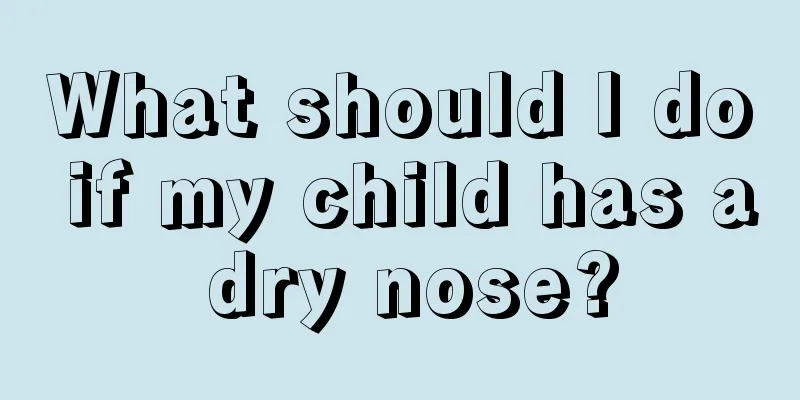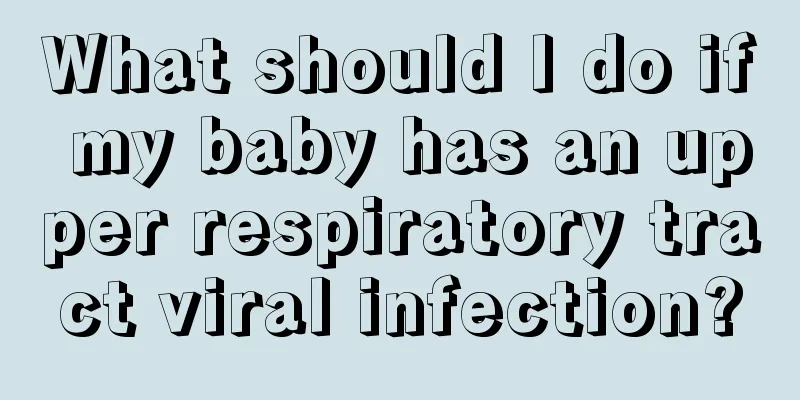What to do if your 2-month-old baby has a cough and stuffy nose

|
Being sick is always a headache for mothers. If a two-month-old baby has symptoms such as coughing and nasal congestion, how should the mother take good care of her baby? We know that coughing and nasal congestion are mostly caused by colds, so to avoid this symptom, we must prevent colds. In addition, in addition to being related to colds, babies' coughs and nasal congestion may also be related to sinusitis. The specific situation needs to be judged based on the baby's other symptoms. If you really can't judge it yourself, it is best to ask a doctor for help. 1. Causes A two-month-old baby has a stuffy nose and cough, which is mainly caused by a cold. Severe nasal congestion may lead to lack of oxygen and even cause the baby's skin to turn blue, known as cyanosis. Acute upper respiratory tract infection in children is an inflammation of the upper respiratory tract caused by various pathogens, referred to as upper respiratory tract infection, commonly known as "cold", and is the most common disease in children. The disease mainly affects the nose, nasopharynx and pharynx. It can be caused by various viruses and bacteria, but more than 90% are viruses, mainly rhinovirus, respiratory syncytial virus, influenza virus, parainfluenza virus, adenovirus, etc. Viral infection may be followed by bacterial infection, the most common of which is hemolytic streptococcus, followed by Streptococcus pneumoniae, Haemophilus influenzae, etc. 2. Prevention Mainly rely on strengthening physical exercise to enhance resistance; promote breastfeeding; prevent and treat rickets and malnutrition; avoid going to crowded public places. If there is a practical air conditioner in the room, put a basin of water in the room, or use a humidifier. If you use a humidifier, use the simplest one without motor or fan noise. Because fresh and moist air can effectively prevent the nasal mucosa of a two-month-old baby from being too dry, and can soften the secretions in the nasal cavity and loosen the secretions. When the baby sneezes and swallows, the secretions can be discharged from the narrow nasal cavity. Keep the room ventilated and open the windows to let fresh air circulate, but avoid blowing directly at the baby, as this will make the baby's blocked nose feel uncomfortable. When the weather is cold, parents should do a good job of keeping the baby warm, such as adding warm quilts and so on. III. Methods The baby should drink small amounts of water multiple times, and the water temperature should not be too hot to avoid irritating the throat. When the baby coughs violently, it is best to hold him/her up to maintain the air temperature. Temperature and cleanliness are very important. At the same time, pat the baby's back gently with your hands to loosen the secretions adhering to the trachea, making it easier to cough out; it also helps dilute the phlegm and make it easier to cough out. If the air is too dry, the phlegm will stick to the trachea wall and will not be easy to be discharged. IV. Precautions A baby's cough and runny nose can help the child expel the cold virus from the body. If their snot changes from clear to yellow and then to green, parents shouldn't worry. This just means that the child's immune system is fighting the virus and doesn't mean he needs antibiotics. You can spray some water into his nose. Use a few drops of saline solution to dilute the dry mucus and have your child blow it out. Humidify the air. Use a humidifier to keep your child's room moist and cool, and pay attention to the hygiene of the humidifier. Another good idea is to let your child take a hot bath in a steamy bathroom. Elevate your child's head. When your child is sleeping, give him a pillow to elevate his head so that his snot will flow more smoothly. For younger children, you can put the pillow under the mattress to make it more comfortable. Keep your baby's room well ventilated. For babies with fever, fresh air helps the skin sweat effectively and lower body temperature. You should avoid blowing air directly towards your baby, as this will cause the blood vessels in your baby's skin to constrict and worsen the condition. Arrange a good rest environment for your baby, keep the room quiet, don't talk loudly, and increase your baby's sleep time as much as possible to reduce energy consumption. You can let your baby lie on the bed, tell him stories softly or listen to music to help him relax, which will promote recovery from the illness. Choose foods that are easily digestible and eat small, frequent meals. The above is a detailed explanation of a two-month-old baby's cough and nasal congestion. No matter what the cause is, if it is not controlled and treated, it will have a certain impact on the baby's growth. Especially if it is caused by sinusitis, if the cause is not discovered in time and treated early, it may aggravate the condition, resulting in poor treatment effect and prolonged treatment time. |
<<: Treatment of infantile hemangioma
>>: What is the reason for foam in children's urine?
Recommend
Can babies watch TV? Parents must pay attention!
When children reach a certain age, they will star...
Why do children often hold their breath?
Many children often suffer from breath holding wh...
Outdoor activities can develop 3 abilities in children
Babies all like to play. If you take your childre...
How to treat baby rhinitis?
The physical health of a baby is of great importa...
Two-year-old baby walks on tiptoe
Two-year-old babies have learned to walk for more...
What to do if your baby's white blood cell count is high
Some babies have problems with their bodies, so t...
What is the normal height and weight for a 4 and a half year old boy?
For many parents, they will find that their babie...
Newborns poop a little bit each time?
After the baby is born, the stomach and intestine...
Why do children sweat?
Adults always sweat when the weather is hot. But ...
Why does my five-year-old child cough so much in the middle of the night?
Everyone will cough sometimes, especially childre...
How to treat a child with fever and convulsions
I believe that careful parents will find that whe...
What are the causes of keratitis in children?
In clinical practice, in addition to finding the ...
How long does it take to straighten teeth at a 12 year old?
Correcting teeth is something that many people ne...
How do teenagers protect their teeth?
In life, we always hear many people constantly si...
The baby in the confinement period has green poop
It is difficult to determine the physical health ...









